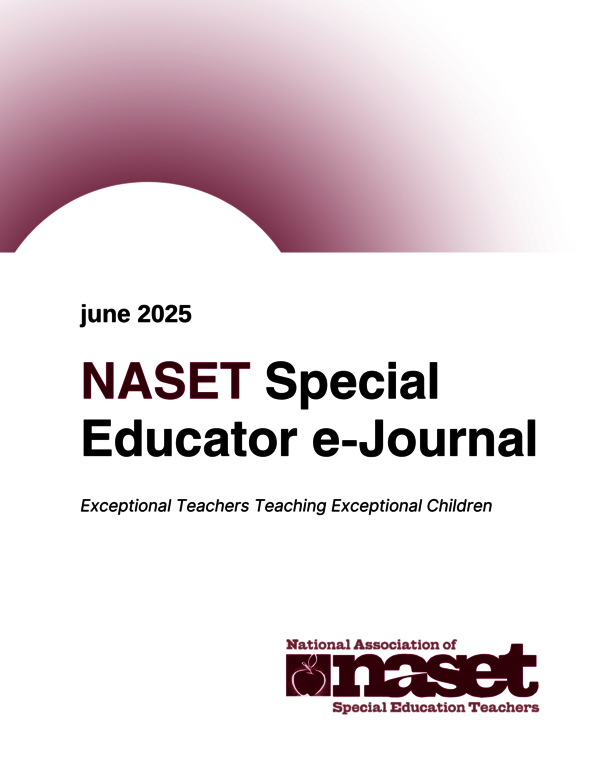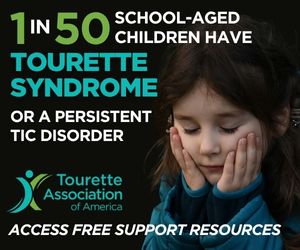June 2025 - Special Educator e-Journal

Download a PDF Version of This e-Journal
NASET Members - Login to Access
Not a Member? - Join NASET Today!
Table of Contents
- Buzz from the Hub
- Special Education Legal Alert. By Perry A. Zirkel
- Update from the US Department of Education
- Article: Navigating the Complexities of Teaching Students with Multiple Disabilities Through Bite-Size Learning for Staff. By Dr. Deborah L. Boldt
- Article: Growth Hormone Deficiency. By Dr. Faye J. Jones
- Article: Student-to-Teacher Ratio and its Effects on Academic Achievement. By Jessica Aveiga
- Latest Employment Opportunities Posted on NASET
- Acknowledgements
NASET Members - Login Below to access the latest Special Educator e-Journal.
Site visitors: You may access a sample e-Journal - Sample e-Journal
Buzz from the Hub
- Behavior and School: How to Participate in the FBA/BIP Process
- Activities to Build Your Child’s Vocabulary at Home
- Family Resource Center from the Child Mind Institute
- It’s My Turn
- Building a Connected Community: Free Online Course from Sesame Street
- Navigating Mental Health Challenges in College
And Many More Articles
NASET Members - Login to Access the Full Article
Not a Member? - Join NASET Today!
Special Education Legal Alert
By Perry A. Zirkel
© June 2025
This month’s update identifies two recent court decisions that cumulatively illustrate child find and what may be considered “partial child find,” with secondary attention to bullying and the statute of limitations, under the IDEA. For previous monthly updates and related publications, see perryzirkel.com
NASET Members - Login to Access the Full Article
Not a Member? - Join NASET Today!
Update from the US Department of Education
- U.S. Department of Education Shares State Guidance on the Unsafe School Choice Option
- Birth to Grade 12 Education-Reources
- Available Grants
- Secretary of Education Statements on President Trump’s Education Executive Orders
Navigating the Complexities of Teaching Students with Multiple Disabilities Through Bite-Size Learning for Staff.
By
Dr. Deborah L. Boldt
Abstract
Educators who support students with severe and profound disabilities face unique challenges that demand specialized instructional strategies and continuous professional growth. These students often experience significant cognitive, physical, and communicative impairments, making traditional teaching methods inadequate. Without meaningful professional development, teachers may lack the tools to effectively engage these learners, potentially impacting student outcomes and teacher confidence. This action research applied the ADKAR Model, part of the Prosci Methodology, to guide change through targeted professional development. Microlearning emerged as an effective approach, offering flexible, bite-size learning modules that support just-in-time learning and long-term retention. By empowering educators to take control of their professional development, microlearning enables them to engage in content at their own pace while addressing real-time classroom challenges thereby enhancing instruction and enhancing the lives of students with disabilities. The study highlights the critical role of adaptive, accessible professional development in empowering special education teachers to meet the demands of today’s inclusive classrooms.
Keywords: disabilities, microlearning, professional development, ADKAR, special education, instructional strategies and educator support.
Growth Hormone Deficiency
By Dr. Faye J. Jones
Growth hormone deficiency (GHD) or pituitary dwarfism, is a rare disorder in which the pituitary gland doesn’t release enough growth hormone or somatotropin (my.clevelandclinic.org/health/diseases/23343-growth-hormone-deficiency-ghd). GHD can affect infants, children and adults.
Hormones control all the cells in the body, controlling the body’s metabolism, growth and many other functions (Hormonal system - what it is and how it works | healthdirect).
The pituitary gland is a small, pea-sized endocrine gland located at the base of the brain below the hypothalamus. The gland is made of two lobes, the anterior or front lobe and the posterior or the back lobe. The anterior lobe makes up Growth Hormone (GH) and releases eight hormones altogether.
NASET Members - Login to Access the Full Article
Not a Member? - Join NASET Today!
Student-to-Teacher Ratio and its Effects on Academic Achievement
By
By Jessica Aveiga
Introduction
Elementary students in an inclusion-modeled class often need more individualized and small-group support to help meet their goals and access the grade-level curriculum, especially if they lack support at home. If these students do not get individualized assistance, they may not be able to access the material in a way that their general education peers do. Many schools, however, are at capacity and are struggling with overflowing classrooms, as buildings are bulging at the seams. There is also the issue of lack of personnel, there are just not enough certified teachers in the workforce to allow for more classes across a grade level. To address this issue of not receiving individualized support or even small group support, prior research has been examined to address the following questions: What student-to-teacher ratio best meets the needs of inclusion students at the elementary level? Is having non-certified personnel (such as aides, teacher assistants, and student teachers) in a co-teach model as effective as having two certified teachers? This review will analyze the effects of smaller class sizes on students and how the benefits, if any, can be implemented using just the same teacher-to-student ratio with an overall larger class size. These research articles will help to compare these questions with the theoretical framework by Lazear, which suggests that smaller class sizes will impact student learning.
NASET Members - Login to Access the Full Article
Not a Member? - Join NASET Today!
Latest Employment Opportunities Posted on NASET
* Teacher for the Visually Impaired - Communicates clearly, asks clarifying questions, and shares insights with confidence. Plans and organizes work with care, holding high standards and showing initiative. Prioritizes patient and family needs through attentive listening and thoughtful follow-up, always aiming to enhance their experience. To learn more- Click here
* Amergis ESN SPED Teacher - We have multiple openings for Extensive Support Needs SPED teachers for next school year! Do you have experience with student populations with severe needs? I would love to chat with you regarding your experience and what you're looking for in your next position. To learn more- Click here
* Special Education Teacher - We are seeking a dedicated and experienced Special Education Teacher to provide individualized academic instruction, develop and implement IEPs, and lead a team of paraprofessionals. The ideal candidate will demonstrate deep expertise in special education, effective classroom management, and a commitment to fostering positive relationships with students, families, and colleagues. To learn more- Click here
Acknowledgements
Portions of this or previous month’s NASET’s Special Educator e-Journal were excerpted from:
- Center for Parent Information and Resources
- Committee on Education and the Workforce
- FirstGov.gov-The Official U.S. Government Web Portal
- Journal of the American Academy of Special Education Professionals (JAASEP)
- National Collaborative on Workforce and Disability for Youth
- National Institute of Health
- National Organization on Disability
- Substance Abuse and Mental Health Services Administration
- U.S. Department of Education
- U.S. Department of Education-The Achiever
- U.S. Department of Education-The Education Innovator
- U.S. Department of Health and Human Services
- U.S. Department of Labor
- U.S. Food and Drug Administration
- U.S. Office of Special Education
The National Association of Special Education Teachers (NASET) thanks all of the above for the information provided for this or prior editions of the Special Educator e-Journal
